“Seeds have the power to preserve species, to enhance cultural as well as genetic diversity, to counter economic monopoly and to check the advance of conformity on all its many fronts.” – Michael Pollan
Now that the bare roots are planted, there really isn’t a whole lot to do. I’m bored, actually, from the lack of gardening activities. Which is why January is prime time to ogle the seed catalogues!
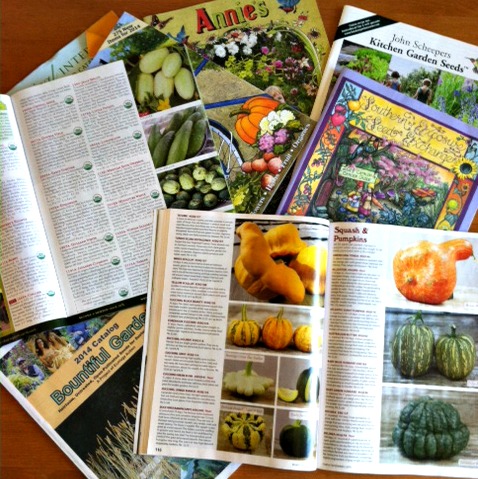
Loaded with beautiful pictures and delectable descriptions, seed catalogues are the one thing that gets gardeners though the winter. They are a messenger of hopes, dreams and the promise of the coming spring.
Winter, gardening, and seed companies must have come together and hired a great marketing company. They know their target market and the best timing: after staring wistfully out your window for a few months, and frost-dead lemon tree progressively dying even more and your kale plants withering away from the lack of rain, its the perfect time for bright colored catalogues to come sailing in though the mail. You are surrounded by the hope of the next growing season touted in the glossy pages. Throw in some exotic and amusing names like Forellenschluss (a lettuce), Hero of Lockinge (a melon), or Golden King of Siberia (a yellow tomato). After looking though pages and pages of all this luscious food, and longing for life in the garden, its easy to forget that eggplants don’t really grow well for you and you don’t actually like peppers: you want them all and they will all grow amazingly!!!!!
There are hundreds of seed catalogues and companies one can support. Its easy to get overwhelmed, not only by the fact there are 400 types of tomatoes, but by the variety of types of seeds to choose. When looking at catalogues, here are some helpful terms to know and consider:
Open-pollinated: These are seeds that came from a plant that were pollinated naturally, be by either bees, wind or other method. They will produce a plant that will look exactly like the parent plant the seed came from. With a few steps to isolate and preserve, seeds from open-pollinated plants can be saved by the average home gardener and planted year after year. Seed companies label these seeds as either open-pollinated or OP.
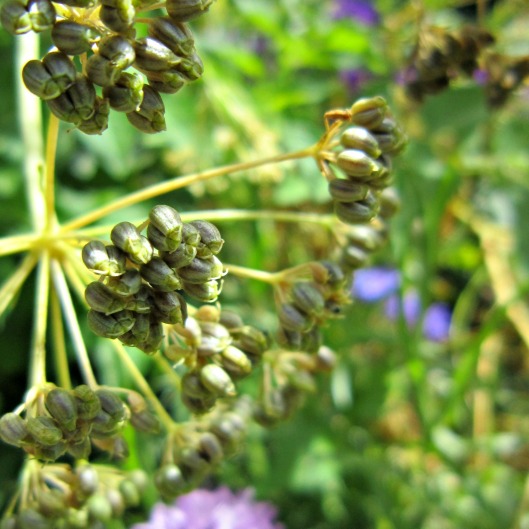
open pollinated Giant of Italy parsley, ready for seed saving
Hybrid: These are seeds that are the first generation of a cross between two varieties. These are not genetically engineered, but a cross made by traditional breeding techniques (think back to 7th grade science and Mendel’s peas). You take a flower from plant A, pollinate plant B with it, and you will get seeds that are plant C. Some people think hybrids are more successful than open-pollinated because they have been bred specifically for things like pest or disease resistance. You can not save seeds from this plant and have it grow into the same plant, and you have to buy your seeds year after year. Seed companies labeled these seeds as either hybrid or F1.
Heirloom: Think of heirloom seeds as the antiques of the seed world. While the seeds themselves are not old, they are always open-pollinated and have been saved for many generations. There is some variation in time frame, but usually seeds are called heirloom if they have been being saved for over 50 years. These varieties are often more flavorful, nutritious and adapted to the local region. Heirloom seeds preserve genetic diversity and cultural heritage.
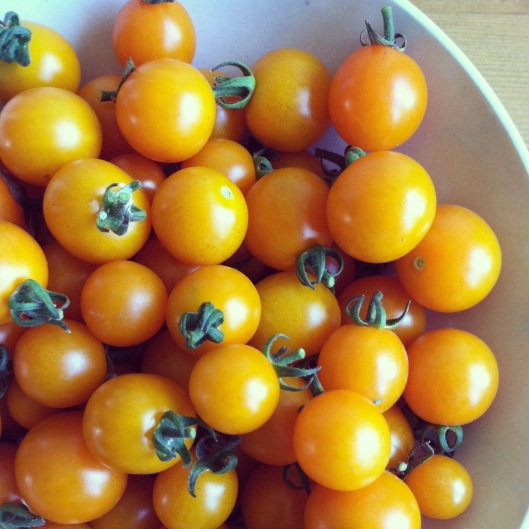
heirloom Sungold Cherry Tomatoes, seeds from Baker Creek
Certified Organic: These seeds come from farms that are inspected by the USDA’s Organic Certification program. Certified organic seeds can not be genetically modified. Certification is expensive, so many seeds may not be certified as organic, but still grown with organic practices. If in question, ask the company about where their seeds are from and how they are grown or produced.
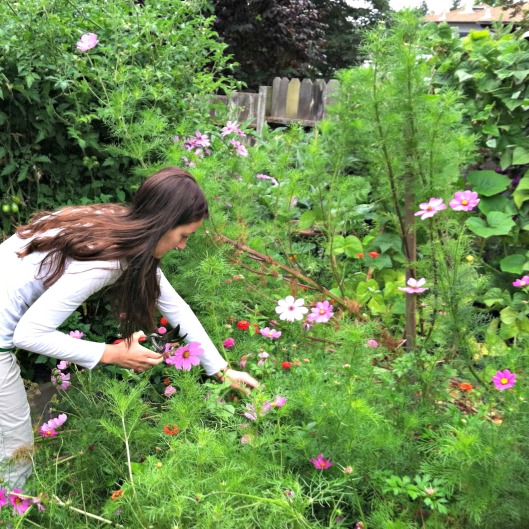
harvesting open pollinated Cosmos and Zinnias, grown for my wedding bouquet, 2012
Non-GMO: Seeds that are labeled as Non-GMO are not certified organic but are GMO free. The main GMO seeds are corn, soy, peanuts, canola, sugar beets and alfalfa. GMO seeds are mostly sold to big agribusiness farms and involve lots of contracts, so they are unlikely to be available in home garden form. However, GMOs can spread via pollen and can contaminate home gardens. Some companies will test their seeds, particularly corn, to ensure what they are selling is GMO free. It is getting harder and harder to get non-GMO corn seed.
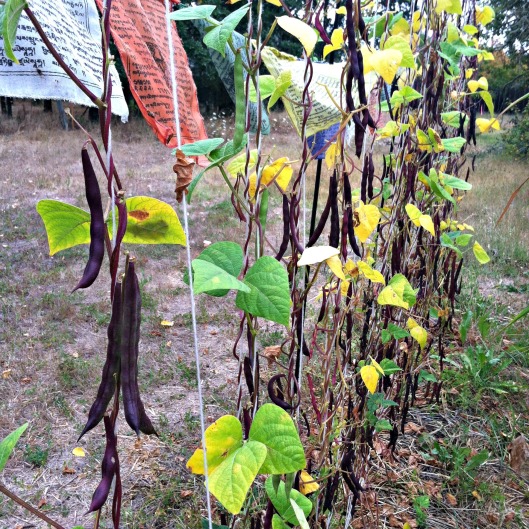
Heirloom Cherokee Trail of Tears beans, growing under prayer flags in last years meager garden
Regardless if you choose to grow certified organic seeds or not, open pollinated or hybrid, I strongly urge you to consider getting seeds from a supplier that does not support genetic engineering or is owned or affiliated with Seminis (Monsanto’s seed brand). Looking for a company that has signed the Council for Responsible Genetics’ Safe Seed Pledge is a good start. These companies have promised that “for the benefit of all farmers, gardeners and consumers who want an alternative, We pledge that we do not knowingly buy, sell or trade genetically engineered seeds or plants….Further, we wish to support agricultural progress that leads to healthier soils, genetically diverse agricultural ecosystems and ultimately healthy people and communities.” You can find a list of the companies that have signed this pledge here. You can also find a crowd-sourced list of seed companies that are GMO-free here. When in doubt, call the company and ask questions!I personally only grow open-pollinated seeds, and prefer heirlooms.
Here are some of my favorite seed companies, and the catalogues I’m currently pouring over:
Baker Creek. This is my go-to seed company. While based in Missouri, their retail seed bank store is local, in Petaluma. I’ve meet the owner, been involved with planning their annual Heirloom Festival, and I love everything about them. However, their catalogue or seed packs don’t give lots of planting details or growing specifics like height or water needs, so having a good gardening book nearby can be useful. http://www.rareseeds.com/
Seed Savers Exchange. Founded in 1975, this non-profit organization has been in the forefront of the heirloom seed movement. Their catalogue has great tips on seed saving and a picture for every description. You can join the organization and exchange seeds with thousands of other members. http://www.seedsavers.org/
Bountiful Gardens. This is the most new-to-me seed produce. Bountiful Gardens is a project of Ecology Action, an almost-local Willits-based organization. They have a wide variety of grain seeds not found in other catalogues, along with many other heirloom seeds. http://www.growbiointensive.org/
Southern Exposure Seed Exchange. Based in Virginia, this company offers seeds best suited to the South. Their catalogue is filled with heirloom things I can’t grow but like to read about, like cotton and peanuts. http://www.southernexposure.com/
Mountain Rose Herbs. For Medicinal Herb Seeds. https://www.mountainroseherbs.com/seeds/seeds.php
What’s your favorite seed company? How do you like to pass the winter time?














7 Comments
Shannon
January 14, 2014 at 3:24 pmExcellent post! Love your picture of the garden of cosmos. I’m sure your new garden is going to be divine this year. I got lazy and impatient — bought seed packets at the local (gasp) Lowe’s home and garden store. Can’t find any of mine from the previous seasons — got lost in the moves. Had to start tomatoes and cucumbers and peppers in my kitchen this week.
Seed catalogs…I should subscribe to some methinks. Maybe for the fall.
Melissa
January 14, 2014 at 5:27 pmorder away! There are lots of companies who are only online, but I love to still look though pages and dream!
Joe Owens
January 14, 2014 at 6:04 pmI love Cosmos. One of my favorite pictures of my daughter is in a field of Cosmos that my wife took. She entered it into a photography competition shortly after she made the picture.
plumdirt
January 14, 2014 at 7:53 pm“you want them all and they will all grow amazingly!!!!!”
Exactly! I mostly order from Baker Creek, with some from Southern Exposure, some from Territorial Seed Exchange, and this year I was gifted some from a new-to-me company called Culpits.
My favorite for living plants is by far Raintree Nursery. We have a four-variety grafted plum tree, my mother has choke cherries and a few others, and a friend recently ordered a pluot from them. Everything has arrived in a timely and healthy manner, and lived for years so far!
I felt like Baker Creek’s catalog was different this year. Fewer pictures, maybe? Or maybe it was just me.
Melissa
January 14, 2014 at 9:31 pmI also have the Territorial catalogue, but never ordered from them before. I do like how broken down into sections they have, like the beans, but I’m a little creeped out by that grafted tomato plant!
I was surprised when I got Baker Creek’s as well, as it was more magazine sized instead of record size. I also noticed they didn’t have some of the varieties they I got from them last year, like my Cherokee Trail of Tears beans. I think they added more of the random things, like the cover crops.
I’ll check out Culpits, I’ve never heard of them!
I’ve heard good things about Raintree as well, glad your trees are doing great!
plumdirt
January 15, 2014 at 7:20 amThat grafted tomato plant is crazy!
Thoughts on September, and Fall Seed Shopping | forgotten skills
September 7, 2014 at 8:37 pm[…] gardeners are familiar with Baker Creek and their heirloom seeds. I’ve written about them before. Lucky for those in Sonoma County, we can visit their […]